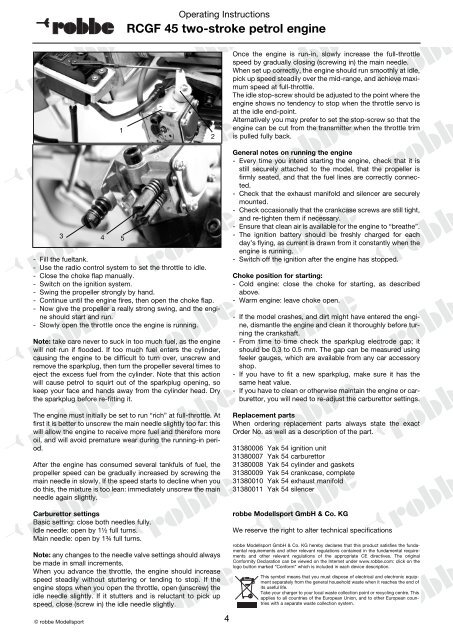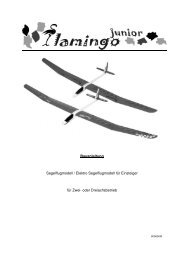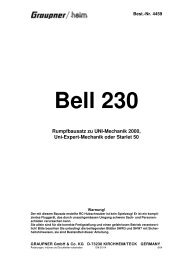Zweitakt-Benzinmotor RCGF 45 - RC-Toy
Zweitakt-Benzinmotor RCGF 45 - RC-Toy
Zweitakt-Benzinmotor RCGF 45 - RC-Toy
Create successful ePaper yourself
Turn your PDF publications into a flip-book with our unique Google optimized e-Paper software.
Operating Instructions<br />
<strong><strong>RC</strong>GF</strong> <strong>45</strong> two-stroke petrol engine<br />
1<br />
2<br />
Once the engine is run-in, slowly increase the full-throttle<br />
speed by gradually closing (screwing in) the main needle.<br />
When set up correctly, the engine should run smoothly at idle,<br />
pick up speed steadily over the mid-range, and achieve maximum<br />
speed at full-throttle.<br />
The idle stop-screw should be adjusted to the point where the<br />
engine shows no tendency to stop when the throttle servo is<br />
at the idle end-point.<br />
Alternatively you may prefer to set the stop-screw so that the<br />
engine can be cut from the transmitter when the throttle trim<br />
is pulled fully back.<br />
3 4<br />
5<br />
- Fill the fueltank.<br />
- Use the radio control system to set the throttle to idle.<br />
- Close the choke flap manually.<br />
- Switch on the ignition system.<br />
- Swing the propeller strongly by hand.<br />
- Continue until the engine fires, then open the choke flap.<br />
- Now give the propeller a really strong swing, and the engine<br />
should start and run.<br />
- Slowly open the throttle once the engine is running.<br />
Note: take care never to suck in too much fuel, as the engine<br />
will not run if flooded. If too much fuel enters the cylinder,<br />
causing the engine to be difficult to turn over, unscrew and<br />
remove the sparkplug, then turn the propeller several times to<br />
eject the excess fuel from the cylinder. Note that this action<br />
will cause petrol to squirt out of the sparkplug opening, so<br />
keep your face and hands away from the cylinder head. Dry<br />
the sparkplug before re-fitting it.<br />
The engine must initially be set to run “rich” at full-throttle. At<br />
first it is better to unscrew the main needle slightly too far: this<br />
will allow the engine to receive more fuel and therefore more<br />
oil, and will avoid premature wear during the running-in period.<br />
After the engine has consumed several tankfuls of fuel, the<br />
propeller speed can be gradually increased by screwing the<br />
main needle in slowly. If the speed starts to decline when you<br />
do this, the mixture is too lean: immediately unscrew the main<br />
needle again slightly.<br />
General notes on running the engine<br />
- Every time you intend starting the engine, check that it is<br />
still securely attached to the model, that the propeller is<br />
firmly seated, and that the fuel lines are correctly connected.<br />
- Check that the exhaust manifold and silencer are securely<br />
mounted.<br />
- Check occasionally that the crankcase screws are still tight,<br />
and re-tighten them if necessary.<br />
- Ensure that clean air is available for the engine to “breathe”.<br />
- The ignition battery should be freshly charged for each<br />
day’s flying, as current is drawn from it constantly when the<br />
engine is running.<br />
- Switch off the ignition after the engine has stopped.<br />
Choke position for starting:<br />
- Cold engine: close the choke for starting, as described<br />
above.<br />
- Warm engine: leave choke open.<br />
- If the model crashes, and dirt might have entered the engine,<br />
dismantle the engine and clean it thoroughly before turning<br />
the crankshaft.<br />
- From time to time check the sparkplug electrode gap; it<br />
should be 0.3 to 0.5 mm. The gap can be measured using<br />
feeler gauges, which are available from any car accessory<br />
shop.<br />
- If you have to fit a new sparkplug, make sure it has the<br />
same heat value.<br />
- If you have to clean or otherwise maintain the engine or carburettor,<br />
you will need to re-adjust the carburettor settings.<br />
Replacement parts<br />
When ordering replacement parts always state the exact<br />
Order No. as well as a description of the part.<br />
31380006 Yak 54 ignition unit<br />
31380007 Yak 54 carburettor<br />
31380008 Yak 54 cylinder and gaskets<br />
31380009 Yak 54 crankcase, complete<br />
31380010 Yak 54 exhaust manifold<br />
31380011 Yak 54 silencer<br />
Carburettor settings<br />
Basic setting: close both needles fully.<br />
Idle needle: open by 1½ full turns.<br />
Main needle: open by 1¾ full turns.<br />
Note: any changes to the needle valve settings should always<br />
be made in small increments.<br />
When you advance the throttle, the engine should increase<br />
speed steadily without stuttering or tending to stop. If the<br />
engine stops when you open the throttle, open (unscrew) the<br />
idle needle slightly. If it stutters and is reluctant to pick up<br />
speed, close (screw in) the idle needle slightly.<br />
© robbe Modellsport<br />
4<br />
robbe Modellsport GmbH & Co. KG<br />
We reserve the right to alter technical specifications<br />
robbe Modellsport GmbH & Co. KG hereby declares that this product satisfies the fundamental<br />
requirements and other relevant regulations contained in the fundamental requirements<br />
and other relevant regulations of the appropriate CE directives. The original<br />
Conformity Declaration can be viewed on the Internet under www.robbe.com: click on the<br />
logo button marked “Conform” which is included in each device description.<br />
This symbol means that you must dispose of electrical and electronic equipment<br />
separately from the general household waste when it reaches the end of<br />
its useful life.<br />
Take your charger to your local waste collection point or recycling centre. This<br />
applies to all countries of the European Union, and to other European countries<br />
with a separate waste collection system.
















